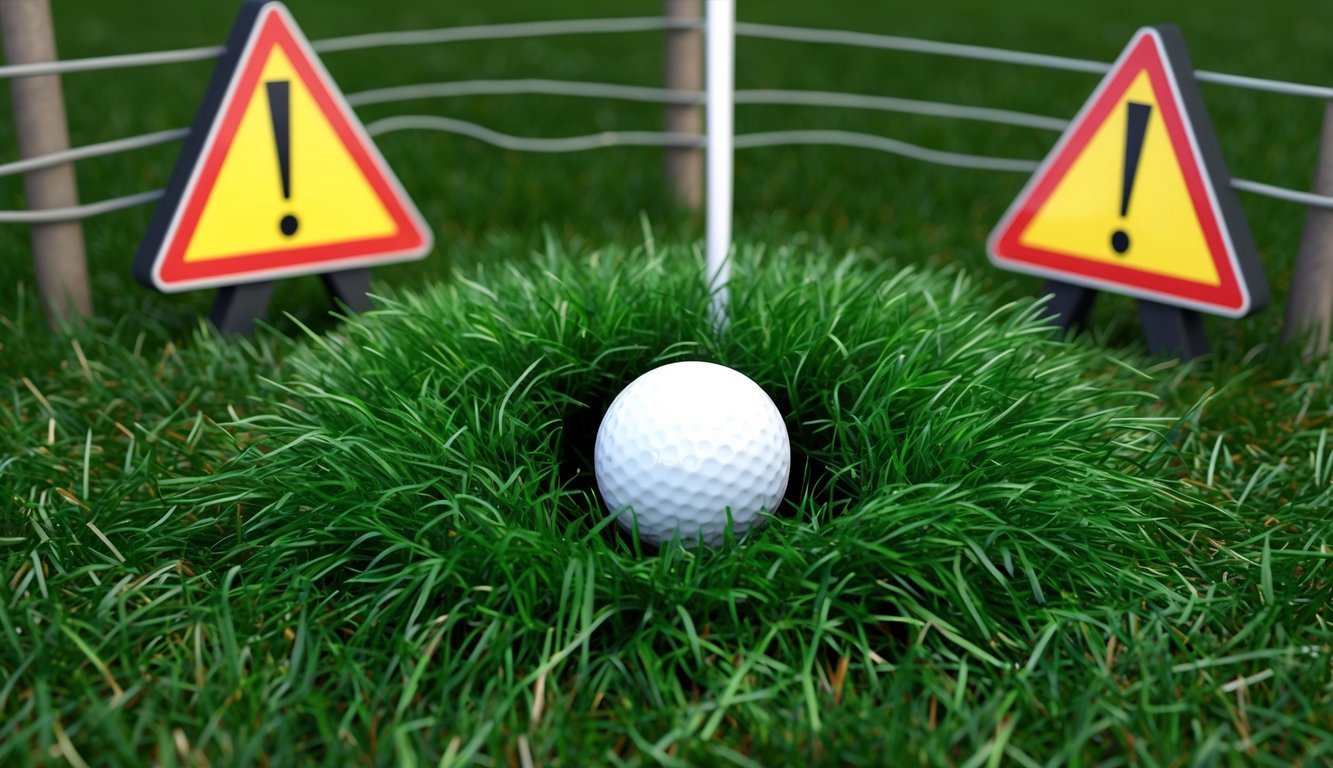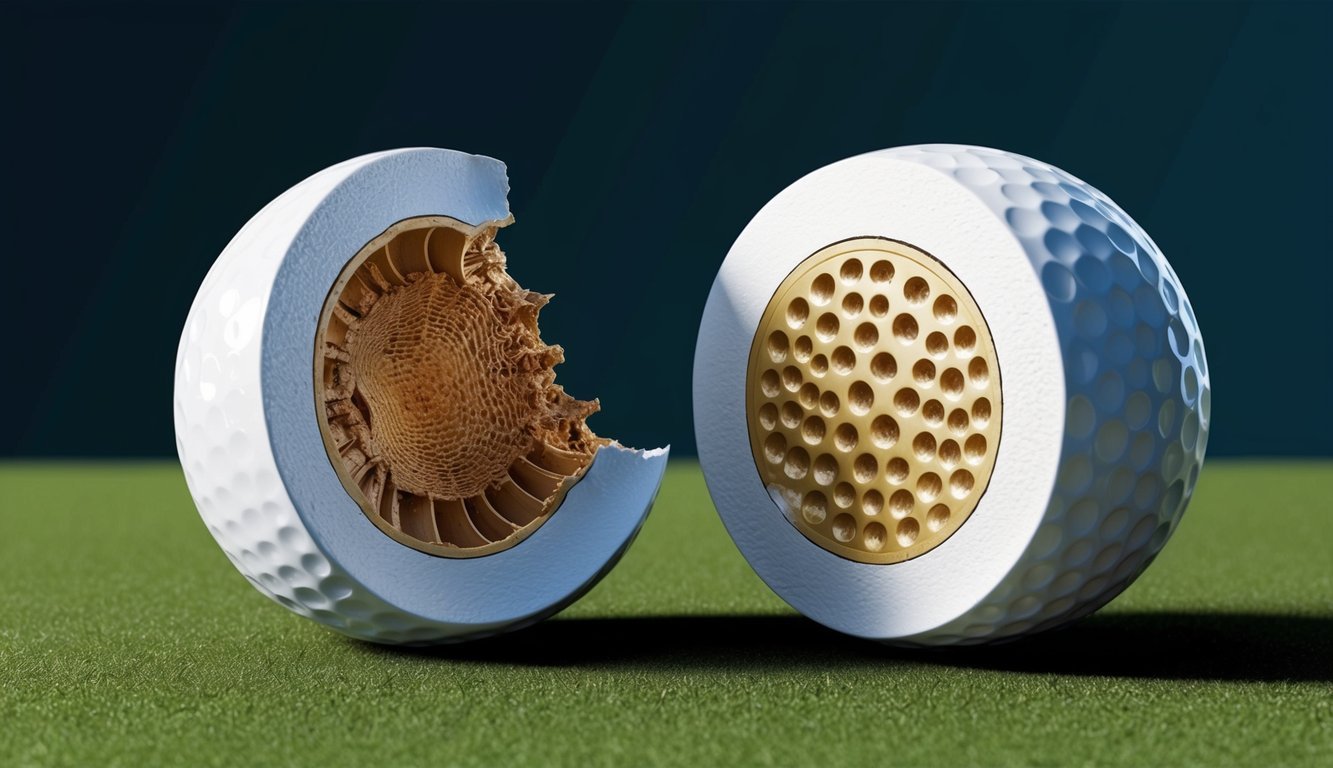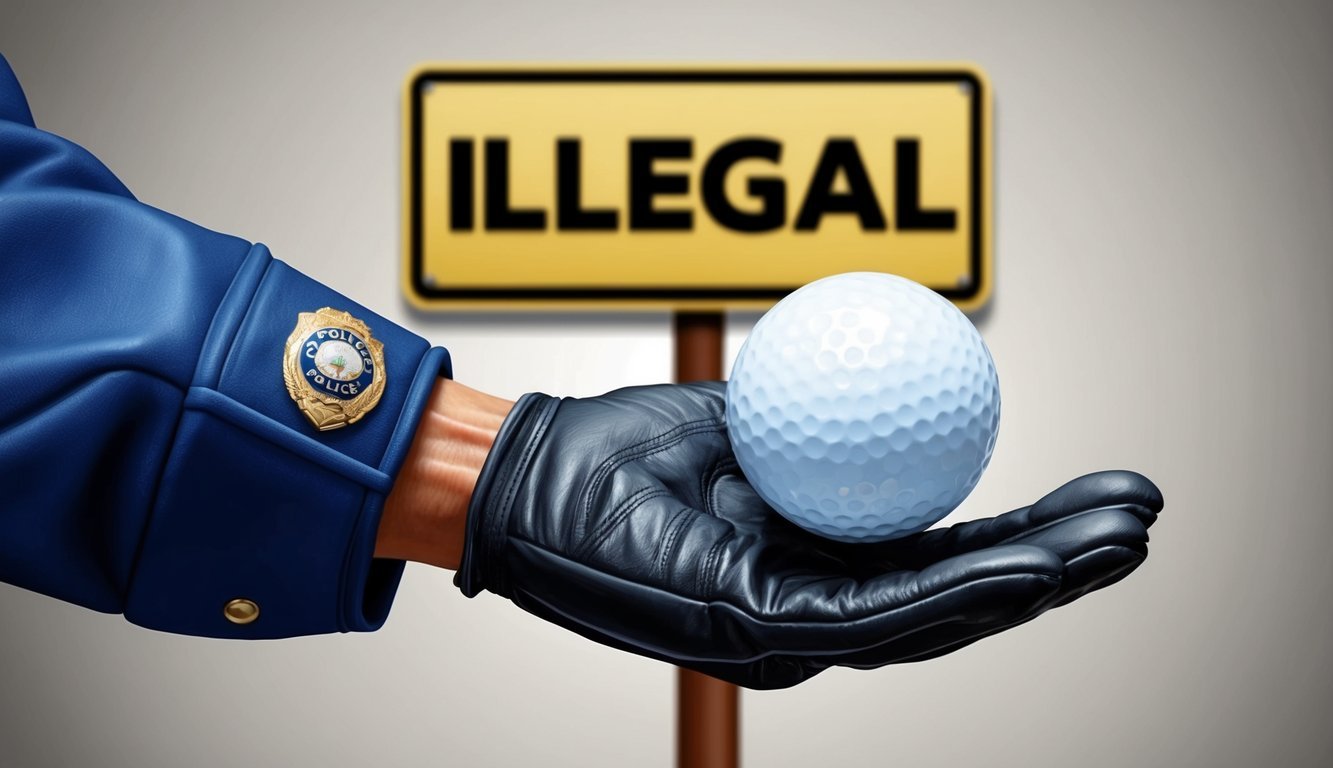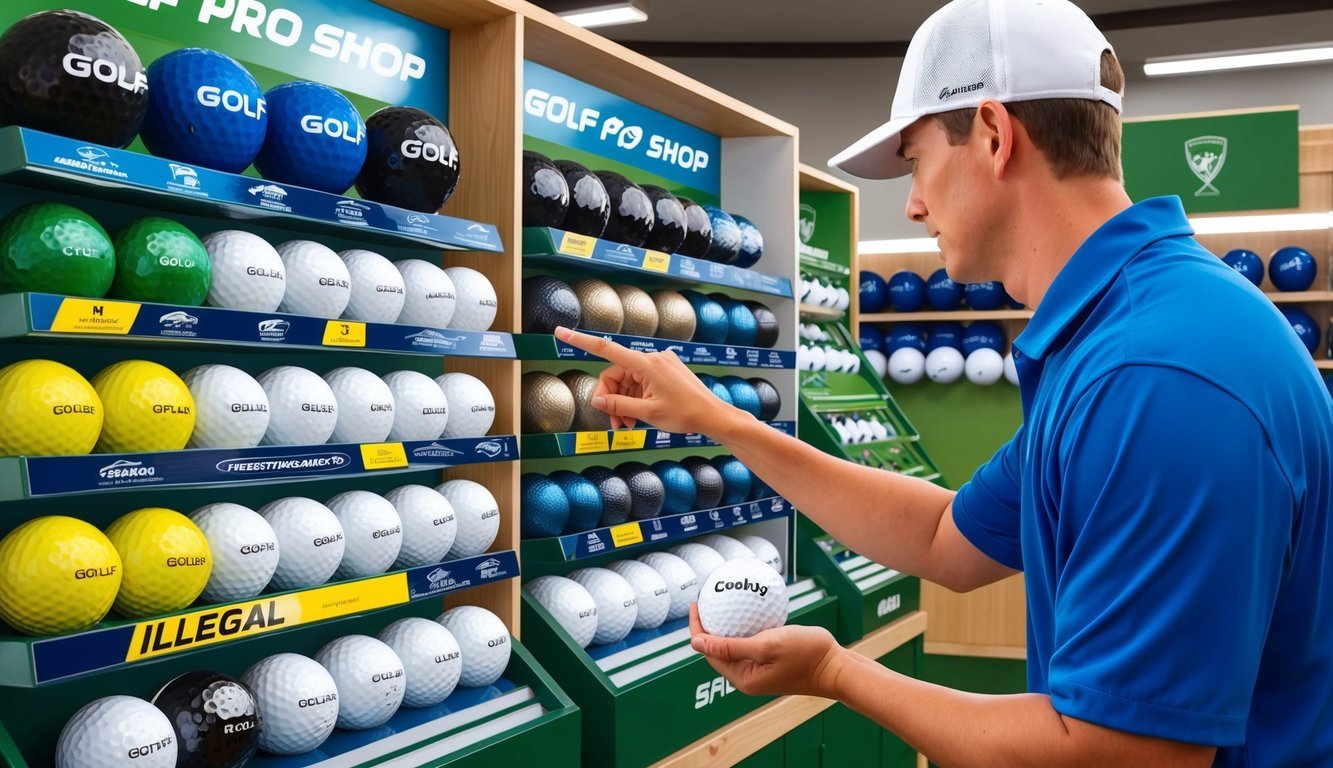Exploring the world of illegal golf balls reveals a realm of intriguing options that many golfers might find irresistible.
These non-conforming balls offer unique features tailored to enhance your play.
Illegal golf balls can travel 10 to 20 yards further than standard balls, providing a noticeable advantage for those seeking a bit more excitement in their game.

As you dive deeper into the technology behind these golf balls, you’ll find variations engineered for distance, accuracy, and even spin control.
Some, like the Polara Self Correcting XDS, are crafted to help straighten out those frustrating slices.
These balls do not meet USGA regulations for official play, which adds a layer of intrigue and exclusivity for casual games.
If you’re curious about trying illegal golf balls, it’s important to evaluate what works best for your style.
From correcting a slice to adding distance, understanding your specific needs can lead you to make more informed choices.
For those willing to step outside the bounds of traditional play, these golf balls may offer a refreshing twist to your usual game.
Key Takeaways
- Illegal golf balls enhance distance and performance.
- Non-conforming balls can correct slicing issues.
- Tailor your golf ball choice to your playing style.
Understanding Golf Ball Design

When exploring the design of a golf ball, it’s important to consider the details of core structure and dimple patterns, the materials that form its multiple layers, and the factors that influence its weight, size, and aerodynamics.
Each aspect contributes to the ball’s overall performance on the course.
Core and Dimple Innovations
The core of a golf ball significantly affects its performance.
Manufacturers play with core designs to enhance distance and control.
Some cores are solid, while others might be multi-layered for greater flexibility and energy transfer.
Adjusting the hardness of the core can lead to variations in how the ball feels upon impact and its overall performance.
Dimples on the surface of the ball are not just for aesthetics.
They are critical for controlling flight path and improving aerodynamic lift.
Different patterns and depths influence stability in the air, helping the ball cut through the wind or increase hang time.
Innovations in dimple designs aim to optimize these aspects, allowing for a more consistent and longer flight.
Materials and Layers
Materials such as Surlyn and ionomer are commonly used in golf ball covers.
Surlyn is durable and scuff-resistant, often chosen for its toughness and balance, making it suitable for beginner and intermediate players.
Ionomer covers can offer a softer feel and might improve short-game control for seasoned golfers seeking precision.
The layers, apart from the core, can vary in number.
Two-, three-, or even multi-layered designs are possible, each offering different attributes.
Multi-layer balls often cater to more experienced players by offering better spin control and feel.
Balancing material choice and layering is essential to meet various player preferences and conditions on the course.
Weight, Size, and Aerodynamics
The weight and size of a golf ball are tightly regulated.
A conforming ball must not weigh more than 1.620 ounces and must have a diameter of at least 1.680 inches.
These specifications ensure consistency across all levels of play.
Aerodynamics play a key role in performance.
Designers strive to maintain an optimal balance between weight, size, and shape for improved ball flight.
By experimenting with micro-adjustments, manufacturers can achieve desirable outcomes, such as increased stability and distance, by reducing drag and enhancing lift.
Regulations on Golf Balls

Understanding the regulations on golf balls is essential for anyone serious about the sport.
The United States Golf Association (USGA) sets specific standards that ensure fair play and maintain the integrity of the game.
Knowing these rules can help you avoid unintentional penalties, especially in official tournaments.
USGA Standards and Rules
The USGA, along with the R&A, establishes the guidelines that dictate whether a golf ball is compliant.
A conforming golf ball must not weigh more than 1.620 ounces (45.93 grams) and must have a minimum diameter of 1.680 inches (42.67 mm).
These measurements are critical as they impact the ball’s performance and consistency.
Additionally, golf balls should be symmetrical to ensure an even flight path.
These standards help maintain a level playing field by preventing technological advancements that could offer unfair advantages.
Ensuring your ball meets these criteria is vital not just for compliance but also to uphold the spirit of the game. The Golf Mine explains that golf balls might be deemed illegal if they enhance distance unfairly.
Impact on Tournament Play
In official tournament play, using a non-conforming golf ball can lead to disqualification or penalties.
These rules are enforced to ensure that all competitors play on equal footing.
The integrity of the sport relies on all players adhering to the same equipment standards.
It’s important for players to verify that their golf balls conform to regulations before starting a tournament.
Many tournaments also implement specific local rules, such as the one-ball rule, which requires players to use the same brand and model throughout the round.
This rule further standardizes the equipment used in competitive play, emphasizing skill over technology.
The USGA offers detailed guidelines for tournament equipment.
Consequences of Using Non-Conforming Golf Balls
Using non-conforming golf balls can jeopardize your standing in a tournament and harm your reputation.
Golf is a sport deeply rooted in ethics and respect for rules, and deviating from them is taken seriously.
Aside from competitive repercussions, there is also a financial aspect to consider.
Penalties can include fines or suspensions, making it crucial to adhere to the standards.
The use of non-conforming equipment can be seen as an attempt to gain an undue advantage, which undermines the principles of fair play.
Players are encouraged to always check their equipment against PGA and USGA regulations to avoid unintentionally violating these important standards.
Advanced Golf Ball Technology for Enhanced Performance

Advanced golf ball technologies are revolutionizing the game by focusing on key aspects such as distance, accuracy, and overall performance.
By employing innovative designs and materials, these advancements offer golfers improved ball speed and the potential for extra distance.
Improving Distance and Accuracy
Modern golf balls feature cutting-edge designs to maximize distance and enhance your accuracy.
Advanced dimple designs reduce air resistance, allowing the ball to travel farther.
The materials used in the core and cover of the ball can significantly affect its performance, too.
For instance, a low-compression core can generate higher velocity and greater ball speed, which results in extra distance off the tee.
Manipulating the spin rate of the ball can also improve accuracy.
A ball with less spin might help you achieve straighter shots, beneficial for average golfers.
With evolving materials and designs, the focus on distributing weight within the ball ensures better flight stability, contributing to more predictable trajectories and improved precision in your game.
Targeting Specific Golf Challenges
Certain technologies are tailored to overcome specific challenges faced by golfers.
If you struggle with maintaining consistent distance, consider distance golf balls specifically designed to maximize yardage even with slower swing speeds.
These balls often feature a high-energy core to increase velocity.
For managing spin and performance around the greens, golf balls with a soft cover can provide enhanced control, allowing you to execute shots with high spin.
This is advantageous in tricky situations where precision is key.
By choosing the right ball variety, any shortcomings, such as insufficient distance or lack of control, can be strategically addressed to refine your game.
The Appeal of Illegal Golf Balls
Illegal golf balls offer unique benefits for players looking to enhance their game.
These balls cater to those aiming for improved distance, better accuracy, and more enjoyable play.
Below, explore how illegal golf balls can make a difference in your golfing experience and the specific models that stand out.
Enhancing Fun and Reducing Frustration
Golf is meant to be fun, but sometimes the game can become frustrating, especially if you struggle with slicing or achieving distance.
Illegal golf balls are designed to help you enjoy the game more by reducing these common issues.
These non-conforming balls can offer slice correction, giving you straighter shots.
For instance, some balls are engineered to be self-correcting, making it easier to have more consistent swings without the usual technical adjustments.
This allows you to focus on the joy of the game rather than constant corrections.
By playing with these balls, you’ll likely find the game less frustrating and more satisfying.
Specific Models and Their Advantages
Several models dominate the illegal golf ball market, each offering unique benefits.
The Polara Ultimate Straight ball is renowned for its slice correction technology, making it popular among players who frequently slice.
It helps shots stay on a straighter path, reducing the frustration linked with off-course balls.
The Bandit Maximum Distance ball is crafted for achieving impressive distance.
It’s a favorite for those looking to add yards to their drives.
Similarly, the MG Senior ball provides added yardage off the tee, specifically designed for senior players seeking more distance.
Each of these balls excels in providing features that conforming balls do not typically offer, making illegal golf balls an intriguing choice for those looking to improve their play or simply have more fun on the course.
Choosing the Right Golf Ball for Your Game

Selecting the optimal golf ball can significantly impact your game.
You need to consider various factors, including your swing speed and personal preferences, to choose the right fit.
Factors to Consider for Golfers
When choosing a golf ball, swing speed is crucial.
Slower swing speeds benefit from low-compression balls that provide a softer feel and help increase distance.
For senior golfers or those with slower swing speeds, this factor is particularly important.
Spin control is another key aspect.
High-spin balls may offer better control and stopping power on greens, while low-spin balls provide more distance.
Understanding your typical ball flight can help determine whether you need more spin or less.
Compression levels vary depending on the ball’s core design. Low-compression balls cater to slower swings, offering enhanced distance and feel.
Higher compression suits players with faster swings, providing better control.
Customization and Personal Preferences
Your choice is significantly influenced by your personal preferences and playing style.
Some golfers prefer a softer ball for more feel, especially around the greens.
Color and visibility can also influence your decision.
If you often struggle to spot standard white balls on the course, opt for bright-colored ones.
You may also want to consider whether you like premium brands or are happy with budget options.
Consulting a buying guide can provide insights into different models and features.
When choosing the right ball for you, evaluate your needs, preferences, and performance goals.
Balancing these elements can lead to a more enjoyable and effective game.

